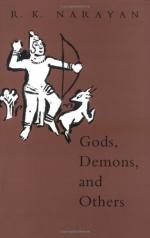|
This section contains 956 words (approx. 3 pages at 400 words per page) |

|
Mount Kailas
This is where Shiva and Pavarti live. Once when the demon Ravana was flying past, the mountain got in his way. He stepped out of his flying chariot and screamed while trying to move the mountain. This is when Shiva gave Ravana his name, which originally was Dasagreeva, meaning 'ten heads', but after this incident he became Ravana, meaning 'scream'.
Fragrant Flowers
Often, at the point in a story when there is a divine intervention, fragrant flowers will appear. For example, when King Dushyanta finally remembers his wife, Shakuntala, fragrant flowers rain down on the assembly as the divine voice speaks out. Also, at the end of King Sibi's tale, when the hawk becomes Indra and the dove becomes the god of fire, the king's flesh in the scale pan turns into fragrant flowers. The flowers are meant to represent the divinity of the gods, but...
|
This section contains 956 words (approx. 3 pages at 400 words per page) |

|




